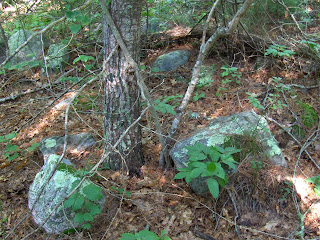Day 1 - Locust hole
Day 2 - Fringes of Webster woods
Day 3 - NE of Thomas Landers
Day 4 - west of Punch Bowl
Day 5 - Bourne Cons lands
Day 6 - WHOI Quisset
Day 2 - Fringes of Webster woods
Day 3 - NE of Thomas Landers
Day 4 - west of Punch Bowl
Day 5 - Bourne Cons lands
Day 6 - WHOI Quisset
More detail about Day 1:
Taking the trail south from Brick Kiln for a while, over hill and dale, I got to a point where there is a wall to the left like this:
 At this place, I headed off in the obvious direction, downhill to the right where there was a developing gully and possibly a kettle hole. I explore all kettle holes because, especially in the Falmouth area, this is one good place to find rock piles.
At this place, I headed off in the obvious direction, downhill to the right where there was a developing gully and possibly a kettle hole. I explore all kettle holes because, especially in the Falmouth area, this is one good place to find rock piles.I encountered a stone wall going down into the hole and, next to it, a first anomaly:
 You can see it is a little ring of stones next to the wall:
You can see it is a little ring of stones next to the wall: Then, a few paces downhill, something I usually would not notice.
Then, a few paces downhill, something I usually would not notice. I suspect this is a deliberate structure since it was near the little circle and the 3 rocks forming a sketchy line parallel to the wall are too far from the wall to be random. I was very pleased, to find a relatively large (for Falmouth) rock pile across the gully from these wall anomalies. You have to be no more than a few feet from things to see them in there.
I suspect this is a deliberate structure since it was near the little circle and the 3 rocks forming a sketchy line parallel to the wall are too far from the wall to be random. I was very pleased, to find a relatively large (for Falmouth) rock pile across the gully from these wall anomalies. You have to be no more than a few feet from things to see them in there. Closer:
Closer: Closest:
Closest: Although it seemed to be an isolated pile, it was only a few paces from the wall and its anomalies. So I felt this was a small but complete site. I did not see anything else and their was water a few more paces downhill.
Although it seemed to be an isolated pile, it was only a few paces from the wall and its anomalies. So I felt this was a small but complete site. I did not see anything else and their was water a few more paces downhill.Mavor wrote about and built a model of a similar ring of stones next to a stone wall over on the Oceanographic's Quisset property. For some time the model was displayed at the Woods Hole Historical Society. In his analysis, he assumed someone sitting in the ring. Now that I think about it, Mavor made the argument that sky-meeting-water defined a point on the horizon which was astronomically significant from the point of view of an observer sitting in the ring. If that is so, I wonder if the rock pile's edge might define a similar such horizon point, where it meets the ground - the pile was in the right sort of place to be observed on a near horizon, across the slope from the ring - visible if there was not so much brush in the way. That would make this a "marker pile".
No comments :
Post a Comment